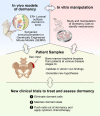Breast cancer dormancy: need for clinically relevant models to address current gaps in knowledge
- PMID: 34050189
- PMCID: PMC8163741
- DOI: 10.1038/s41523-021-00269-x
Breast cancer dormancy: need for clinically relevant models to address current gaps in knowledge
Abstract
Breast cancer is the most commonly diagnosed cancer in the USA. Although advances in treatment over the past several decades have significantly improved the outlook for this disease, most women who are diagnosed with estrogen receptor positive disease remain at risk of metastatic relapse for the remainder of their life. The cellular source of late relapse in these patients is thought to be disseminated tumor cells that reactivate after a long period of dormancy. The biology of these dormant cells and their natural history over a patient's lifetime is largely unclear. We posit that research on tumor dormancy has been significantly limited by the lack of clinically relevant models. This review will discuss existing dormancy models, gaps in biological understanding, and propose criteria for future models to enhance their clinical relevance.
Conflict of interest statement
The authors declare no competing interests.
Figures





References
-
- Howlader, N. et al. SEER Cancer Statistics Review, 1975–2016. National Cancer Institute (2019).
Publication types
Grants and funding
- R01CA200970/U.S. Department of Health & Human Services | National Institutes of Health (NIH)
- 2R01CA155243/U.S. Department of Health & Human Services | National Institutes of Health (NIH)
- R35 CA197585/CA/NCI NIH HHS/United States
- R01 CA200970/CA/NCI NIH HHS/United States
- R01 CA155243/CA/NCI NIH HHS/United States
LinkOut - more resources
Full Text Sources
Other Literature Sources
Miscellaneous

